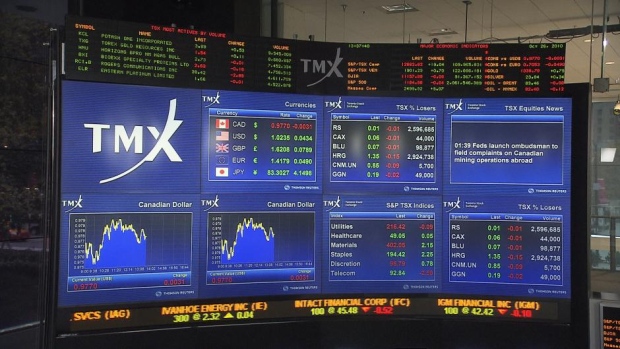Mar 17, 2017
TSX ends lower on declines in financial, resource stocks
, Reuters

Canada's benchmark stock index fell on Friday as financial stocks lost ground along with bond yields and as natural resource companies pulled back despite an uptick in commodity prices.
The heavyweight financials group lost 0.6 per cent, with insurance company Manulife Financial Corp down 1.5 per cent at $24.13 and Brookfield Asset Management Inc off 0.8 per cent at $48.47.
The country's biggest banks fell between 0.4 and one per cent.
The moves echoed similar slips on Wall Street as the effects of the U.S. Federal Reserve's less aggressive stance on future rate hikes from earlier in the week lingered.
"This week everything was waiting with bated breath for what the Fed was going to say," said Irwin Michael, portfolio manager at ABC Funds. "The question was what sort of commentary that'd give on the guidance, and they indicated it would be slow but steady."
The Toronto Stock Exchange's S&P/TSX composite index ended down 71.92 points, or 0.46 per cent, at 15,490.49. The index slipped 0.1 over the week.
Seven of the index's 10 main groups ended in negative territory, with decliners outnumbering gainers by 2.3 to 1.
"On balance, people are looking for liquidity in this market, because there is still a lot of uncertainty."
The telecom and utilities groups, which tend to receive more buying interest when investors are feeling defensive, both gained.
Telecom company BCE Inc advanced 1.3 per cent to $58.30 and rival Telus Corp added 0.5 per cent to $42.97.
The energy group fell 0.6 per cent, with pipeline company Enbridge Inc down 1.3 per cent at $54.96, while the materials group, which includes precious and base metals miners and fertilizer companies, fell 0.9 per cent.
Dominion Diamond Corp jumped 12.2 per cent to $13.21 after providing a 2018 outlook late on Thursday.
Oil prices were steady, finishing the week with modest gains, but speculators sharply cut long positions during last week's rout, on concerns that an OPEC production cut was failing to reduce a global supply overhang.
Gold and copper prices rose.
Canada Goose added 6.8 per cent to $23.00 the day after it jumped nearly 27 per cent from its initial public offering price of $17 per share.
Canadian manufacturing sales unexpectedly rose in January for the third month in a row, helped by strength in non-durable goods, including petroleum and coal products, data from Statistics Canada showed on Friday.
U.S. MARKETS
U.S. stocks dipped on Friday as bank shares fell alongside Treasury yields while Adobe helped buoy the S&P tech sector and the Nasdaq Composite.
Amgen was the largest drag on both the S&P 500 and Nasdaq, down 6.4 per cent at US$168.61, after the extent of a cholesterol drug's benefits in a highly anticipated study disappointed investors, even if it cut the risk of heart attacks and strokes by over 20 per cent in patients with heart disease.
The S&P tech index was supported by Adobe's surge to a record high of US$130.30 after the Photoshop software maker reported strong earnings. The stock ended up 3.8 per cent at US$127.01.
Indexes were little changed for a second day even if the Nasdaq Composite touched a record intraday high. Analysts say investors are expecting a catalyst to thrust stocks higher after bets on President Trump's promises of tax cuts and a fiscal stimulus drove Wall Street to all-time highs on a weeks-long rally.
"Investors are moving from sector to sector dependent on where the U.S. dollar is, comments from the White House on the health care act, and earnings," said Quincy Krosby, market strategist at Prudential Financial in Newark, New Jersey.
"The 10-year [benchmark U.S. Treasury note yield] dipped below 2.5 per cent and financials pull back while utilities get bid. This churn is a way for the market to consolidate."
Analysts increasingly worry that the Trump administration is spending too much of its political capital in an effort to pass a Republican-proposed healthcare bill, which may leave it wanting for support when it tries to reform the tax code.
Bets on the passing of a tax reform are one of the pillars of the equities rally since the November presidential election.
"This is a market waiting for its next catalyst and I think it wants to hear it from the White House," Krosby said. "That's very important for a market that embraced the pro-growth agenda of the Trump administration."
The Dow Jones Industrial Average fell 19.93 points, or 0.1 per cent, to end at 20,914.62, the S&P 500 lost 3.13 points, or 0.13 per cent, to 2,378.25 and the Nasdaq Composite added 0.24 point, or zero per cent, to 5,901.00.
For the week the S&P rose 0.2 per cent, the Dow gained less than 0.1 per cent and the Nasdaq added 0.7 per cent.
The S&P 500's financial sector posted its first back-to-back weekly decline since September.
Tiffany touched a 19-month high of US$94 after higher-than-expected quarterly results. Shares of the high-end jeweler closed up 2.7 per cent at US$92.42.
About 9.68 billion shares changed hands in U.S. exchanges, compared with the 7.1 billion daily average over the last 20 sessions.
Advancing issues outnumbered declining ones on the NYSE by a 1.51-to-1 ratio; on Nasdaq, a 1.43-to-1 ratio favored advancers.
The S&P 500 posted 64 new 52-week highs and three new lows; the Nasdaq Composite recorded 175 new highs and 58 new lows.





